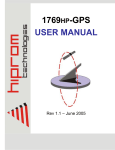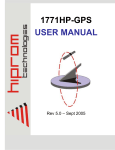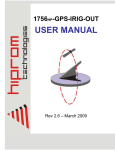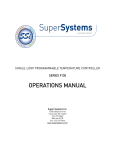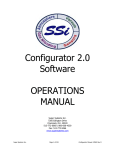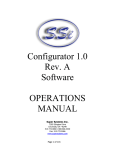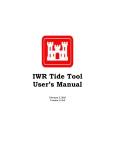Download 1746HP-GPS USER MANUAL
Transcript
1746HP-GPS USER MANUAL Rev 3.0 – Sept 2005 1746HP-GPS - User Manual Rev 3.0 Table of Contents Chapter 1 Chapter 2 Chapter 3 Chapter 4 Chapter 5 Chapter 6 Chapter 7 Introduction.......................................................................................................3 Module Accessories .........................................................................................4 Module Operation.............................................................................................5 Installing the Module ........................................................................................9 Configuring the Module ..................................................................................11 I/O Address Map ............................................................................................14 Module Status ................................................................................................27 Appendix A PLC Ladder Example .....................................................................................30 Appendix B Specifications .................................................................................................44 Appendix C Glossary .........................................................................................................45 . Page 2 of 46 1746HP-GPS - User Manual Rev 3.0 CHAPTER 1 INTRODUCTION Hiprom Technologies presents a Global Positioning System (GPS) based Time Stamping Input module for the Allen-Bradley SLC (1746- family of PLC’s). The 1746HP-GPS module provides precision time stamped events of both the 16 external inputs and 16 internal PLC bits. In addition the 1746HP-GPS module provides GPS time, position and velocity measurement together with GPS status information. This document serves to describe the functionality, installation, configuration and use of the module. . Page 3 of 46 1746HP-GPS - User Manual Rev 3.0 MODULE ACCESSORIES CHAPTER 2 Each 1746HP-GPS package includes the following components: • • • • • 1746HP-GPS module 5m RG58 patch lead with a SMA male and TNC male connector on either end 3.3V active 50Ω hard mount antenna 1746HP-GPS user manual HTSB bus cable (slave modules) GPS HIPROM HIPROM GPS Lock PPS LOC OK Figure 2.1 : 1746HP-GPS module with antenna and patch-lead . Page 4 of 46 1746HP-GPS - User Manual Rev 3.0 MODULE OPERATION CHAPTER 3 The 1746HP-GPS module is designed to operate within the Allen-Bradley 1746 backplane. All power required for the module’s operation is derived from the 1746 backplane. HIPROM GPS Lock Alpha-numeric LED Display Port 1 - HTSB Input (RJ9) Port 2 - HTSB Output (RJ9) GPS Antenna Port ( SMA ) Input Connectors In 0 In 1 In 2 In 3 In 4 In 5 In 6 In 7 NC Common (Inputs 0-7) In 8 In 9 In 10 In 11 In 12 In 13 In 14 In 15 NC Common (Inputs 8-15) Figure 3.1 : 1746HP-GPS Layout . Page 5 of 46 1746HP-GPS - User Manual Rev 3.0 The 1746HP-GPS module makes use of the Global Position System (GPS) to provide accurate time stamping of PLC and external events. Events are triggered by a change in either: • • the switching of any of the external 16 digital inputs, (External) Or the changing of any of the bits in one of the module’s PLC output image registers. (Internal) External Inputs The 16 external inputs are arranged in 2 banks of 8 channels each. These banks are electrically independent from each other, having their own commons. The inputs are optically isolated and available in either 24Vd.c. or 110Vd.c. Digital Filtering In order to prevent unnecessary events from being triggered due to contact bounce, etc. each external input is digitally filtered. Once an event has triggered on a specific input, that channel is ignored for the duration of the filter constant. This filter constant is common for all 16 channels and can be configured via the module’s output image. Internal Inputs Events are also triggered by a transition of any one or more of the 16 internal memory bits. These bits occupy word 17 of the module’s SLC output image. Event Processing Each event that is triggered is logged to the event buffer within the 1746HP-GPS module. This event buffer -- which can store up to 1000 events -- operates in a first-in-first-out mode. Each entry in the event buffer stores the following information pertaining to that specific event : • • • • • • Event ID Date Time Validity of Time Stamp Snapshot of Physical & Memory Inputs Trigger Mask (Cause of the Event) If there is an unread event in the event buffer, then the 1746HP-GPS module notifies the SLC by raising a flag (BRD) located in the module’s PLC input image. The user’s PLC software should monitor this flag, and when ready, toggle the NXT bit, in order to read the event. . Page 6 of 46 1746HP-GPS - User Manual Rev 3.0 A 0 to 1 transition of the NXT bit will transfer the next event from the module’s buffer into the SLC input image, and will be available to be read by the SLC on the next scan. Should the event buffer still contain an event, then the BRD flag will remain set and the user software should execute a further transfer. Once the event buffer is empty the BRD flag will be cleared. Current Date Time Current date and time information is available directly across the backplane in the input image. The time can be configured to any time zone by setting the UTC offset -- the difference between the required local time standard and GMT. To allow for time zones that are a fraction of an hour from GMT, the time zone offset must be multiplied by 10 before being written to the module. For example, to select Pacific Standard Time (GMT - 8), set the time zone = -80. Refer to examples listed in the Appendix. Current Position & Velocity Current GPS position and velocity is available in 2 modes : • Polar: Latitude, Longitude, Altitude • Cartesian: Earth-Centred Earth-Fixed The mode can be selected via the ECF flag in the modules output image. If both co-ordinate systems are required then this bit can be toggled every second. It is important to check the status of the PEC flag to determine the format of the current position before using the data. Similarly, the VEC flag should be examined before reading the velocity data. GPS Receiver Status Certain GPS receiver statuses are made available to the SLC. These include: • • • • • • GPS Satellite Lock Pulse per Second Differential Mode (DGPS) Position Dilution of Precision Alarm Antenna Status Number of Satellites used in fix. Master / Slave Topology The precise time-stamping in the module is achieved by synchronization with the GPS satellite system. . Page 7 of 46 1746HP-GPS - User Manual Rev 3.0 The 1746HP-GPS-Master module has an on-board GPS receiver providing timesynchronisation information not only to itself, but also to other adjacent Slaves by means of the HTSB output port. The Master module must be connected to an antenna positioned with an unimpeded view of the sky. . Page 8 of 46 1746HP-GPS - User Manual Rev 3.0 CHAPTER 4 INSTALLING THE MODULE GPS utilizes a spread spectrum signal in the 1.5GHz range, and thus cannot penetrate conductive or opaque surfaces. Thus the antenna should be mounted in a horizontal position with an unobstructed view of the sky. Attach the antenna patch lead to the antenna. It is recommended that waterproofing tape be used to seal the connection. NOTE: Should a longer patch lead be required it is recommended that a GPS signal booster is used. Contact your local Hiprom Technologies distributor for assistance. Attach the patch lead SMA (male) to the module’s SMA (female) connector. It is not recommended that the antenna patch lead exceed a total loss of 10dB at 1.5GHz, as this may increase the time to GPS lock, or in extreme cases, prevent GPS lock from being achieved at all. HIPROM GPS Lock HIPROM GPS Lock HTSB CABLE Antenna HIPROM GPS Lock Coax 50 ohm Figure 4.1 : 1746HP-GPS Master / Slave setup . Page 9 of 46 1746HP-GPS - User Manual Rev 3.0 Once the module has been power up for the first time, it will search for satellites from a cold start (i.e no almanac). The module will take approximately 5 minutes to acquire Lock. Once a complete almanac has been downloaded, the time to achieve fix will be reduced to around 45 seconds. MASTER / SLAVE CONFIGURATION Slave modules are connected to adjacent Master or other Slave modules by means of an HTSB bus cable (refer to figure 3.1). All 1746HP-GPS modules are equipped with an HTSB input and output port. Take care to ensure that the HTSB Output port (lower) of the Master module is connected to the HTSB Input port (upper) of the next Slave module. Incorrect connection of the HTSB bus cable could result in permanent damage to the module. HTSB BUS CABLE The HTSB cable consists of 4 cores terminated on either side with RJ-9 connectors. The cable should not exceed 1 meter in length and should not be exposed to high electrical noise environments. TP+ TPPS+ PSFigure 4.2 : HTSB Bus cable . Page 10 of 46 1746HP-GPS - User Manual Rev 3.0 CHAPTER 5 CONFIGURING THE MODULE . A direct connection between the controller and the 1746HP-GPS module is required to transfer I/O data to and from the module. Establishing the Direct Connection This section describes the procedures necessary to configure the 1746HP-GPS module within the 1746 SLC system. Figure 5.1 : Right-click on I/O Configuration and select Open . Page 11 of 46 1746HP-GPS - User Manual Rev 3.0 Figure 5.2 : Left-click on Read I/O Config Before the IO can be read, a connection must be established between RSLogix and the PLC system. Figure 5.3 : Left-click on Read I/O Config . Page 12 of 46 1746HP-GPS - User Manual Rev 3.0 Figure 5.4 : Confirmation that the 1746HP-GPS module has been identified . Page 13 of 46 1746HP-GPS - User Manual Rev 3.0 I/O ADDRESS MAP CHAPTER 6 The input and output image of the 1746HP-GPS module is defined in the following sections. 6.1 Input Image Word I:e.0 15 14 13 12 11 10 9 8 7 6 5 4 3 2 1 0 I:e.1 NSH EWH PEC VEC Rsv OVF BRD DTV AER ANT BAT PDP PPS DIF LOC SKY SV Count Rsv Rsv Rsv Rsv Rsv Rsv Rsv Rsv Rsv Rsv Rsv Rsv I:e.2 Milliseconds I:e.3 Seconds I:e.4 Minutes I:e.5 Hours I:e.6 Day I:e.7 Month I:e.8 Latitude - ( Seconds x 100) or Position X - ( metres x 1) I:e.9 Latitude - ( Minutes) or Position X - ( metres / 10,000) I:e.10 Longitude - ( Seconds x 100) or Position Y - ( metres x 1) I:e.11 Longitude - ( Minutes ) or Position Y - ( metres / 10,000) I:e.12 Altitude - ( meters x 1) or Position Z - ( metres x 1) I:e.13 Altitude - ( meters / 10,000) or Position Z - ( metres / 10,000) I:e.14 Velocity North - ( m/s x 10) or Velocity X - ( m/s x 10 ) I:e.15 Velocity East - ( m/s x 10) or Velocity Y - ( m/s x 10 ) I:e.16 Velocity Up - ( m/s x 10) or Velocity Z - ( m/s x 10 ) I:e.17 I15 I14 I13 I12 I11 I10 I09 I08 I07 I06 I:e.18 Event Buffer Count I:e.19 Event ID I:e.20 Event Month I:e.21 Event Day I:e.22 Event Hour I:e.23 Event Minute I:e.24 Event Second I:e.25 Event Millisecond I:e.26 Event Input Status I05 I:e.27 Event Input Change I:e.28 Event Memory Status I:e.29 Event Memory Change I:e.30 I:e.31 Channel SV PRN I04 I03 I02 I01 I00 SV Signal Strength Rsv Rsv Rsv Rsv Rsv Rsv Rsv Rsv Rsv Rsv Rsv Rsv Rsv Rsv Rsv Rsv Figure 6.1 : Connected Input Image * Rsv = Reserved for future use. . Page 14 of 46 1746HP-GPS - User Manual Rev 3.0 Input Image (Continued) SKY Visible Sky I:e.0/0 0 = Sky not visible or no satellite signals present 1 = Satellite signals available No sky usually indicates that the antenna does not have a clear view of the sky, such as in a building, etc. LOC Satellite Lock I:e.0/1 0 = Not tracking sufficient satellites to provide positional fix 1 = Sufficient satellites being tracked to provide positional fix Typically, tracking 4 satellites is sufficient to provide lock. DIF Differential Correction Mode I:e.0/2 0 = No acceptable differential GPS Corrections being received 1 = Acceptable Differential corrections being received and are being used in the position calculations. Differential corrections in the industry standard protocol RTCM-SC104 can be passed to the module via Port-2 (RJ-9) on the front of the module. These correction factors cancel certain inherent errors such as ionospheric delays and thus render a more accur PPS Pulse per Second I:e.0/3 This bit transitions from 0 to 1 precisely every second. The pulse duty cycle is approximately 50%. PDP PDOP OK I:e.0/4 0 = Position Dilution of Precision is unacceptable 1 = No Position Dilution of Precision present Position Dilution of Precision occurs when although there are sufficient satellites in lock, 2 or more of them appear to occupy similar positions in the sky and thus the number of effective satellites is decreased. . Page 15 of 46 1746HP-GPS - User Manual Rev 3.0 Input Image (Continued) BAT Battery Backup on Boot I:e.0/5 0 = No battery backup available on boot-up. 1 = Battery backup available on boot-up. Battery backup is enabled by setting the jumper J107 to the ON position. With battery backup enabled the time taken for the GPS module to regain satellite lock is greatly reduced. It is recommended that if the module is not to be used for an extended period that the battery backup be disabled. ANT Antenna OK I:e.0/6 0 = Antenna Fault 1 = Antenna OK An Antenna fault will occur if the antenna is not present or has been damaged. AER Antenna Short / Open I:e.0/7 0 = Antenna Open Circuit 1 = Antenna Short Circuit Indicates the type of Antenna fault. DTV Date / Time Valid I:e.0/8 0 = Date Time Not Valid 1 = Date Time synchronized with GPS BRD Ready for Event Transfer I:e.0/9 0 = No Events in buffer 1 = One or more events in buffer which are ready for transfer to the Input Image OVF Buffer Overflow Latch I:e.0/10 0 = Buffer has not overflowed. 1 = Buffer has Overflowed. This Latch will be set when more than 1000 events have been logged to the buffer but not yet transfered to the Input Image. Once the buffer has Overflowed this bit will remain set until an Overflow Latch Clear (CLR) command has been issued. . Page 16 of 46 1746HP-GPS - User Manual Rev 3.0 Input Image (Continued) VEC Last Velocity Vector in ECEF Mode I:e.0/12 0 = Velocity Update in Northing, Easting and Upward format 1 = Velocity Update in Earth-Centred-Earth-Fixed X,Y,Z format ECEF Mode can be invoked by setting the ECF bit in the output image. (O:e.0/3) PEC Last Position Vector in ECEF Mode I:e.0/13 0 = Position Update in Latitude, Logtitude and Altitude format 1 = Position Update in Earth-Centred-Earth-Fixed X,Y,Z format ECEF Mode can be invoked by setting the ECF bit in the output image. (O:e.0/3) EWH Current East / West Hemisphere I:e.0/14 0 = Current position in East hemishere 1 = Current position in West hemisphere This flag is Not valid when in ECEF mode is invoked. NSH Current North / South Hemisphere I:e.0/15 0 = Current position in North hemishere 1 = Current position in South hemisphere This flag is Not valid when in ECEF mode is invoked. SV Count Number of Satellites used in GPS Fix This indicates the number of satellites used in the current GPS position / time fix, as a 4-bit nibble between 0 - 8. I:e.1/0 thru I:e.1/3 Milli- Real Time Milliseconds seconds Current real time Milliseconds ( 0 - 999 ) Seconds Real Time Seconds I:e.2 I:e.3 Current real time Seconds ( 0 - 59 ) Minutes Real Time Minutes I:e.4 Current Local time Minutes ( 0 - 59 ) This is dependent on the configured time zone (O:e.2) . Page 17 of 46 1746HP-GPS - User Manual Rev 3.0 Input Image (Continued) Hours Real Time Hours I:e.5 Current Local time Hours ( 0 - 23 ) This is dependent on the configured time zone (O:e.2) Day Calendar Day of Month I:e.6 Current Local Calendar Day ( 1 - 31 ) This is dependent on the configured time zone (O:e.2) Month Calendar Month I:e.7 Current Local Calendar Month ( 1 - 12 ) This is dependent on the configured time zone (O:e.2) Latitude Current Position Latitude I:e.8 (PEC = 0) Degrees = integer (I:e.9 / 60) I:e.9 Minutes = I:e.9 mod 60 Seconds = I:e.8 / 100 Only Valid if the PEC flag (I:e.0/13) = 0 OR Position X Distance from Earth-centre along the X - axis. (PEC = 1) X-Position = (I:e.8 + ( I:e.9 x 10,000)) in metres Position is calculated with respect to the WGS-84 Earth-Centred Earth-Fixed co-ordinate system. The X-axis is defined as the vector with origin at the earth's centre and passing through the intersection of the equator and Greenwich meridian. Only Valid if the PEC flag (I:e.0/13) = 1 . Page 18 of 46 1746HP-GPS - User Manual Rev 3.0 Input Image (Continued) Longitude Current Position Longitude I:e.10 (PEC = 0) Degrees = integer (I:e.11 / 60) I:e.11 Minutes = I:e.11 mod 60 Seconds = I:e.10 / 100 Only Valid if the PEC flag (I:e.0/13) = 0 OR Position Y Distance from Earth-centre along the Y - axis. (PEC = 1) Y-Position = (I:e.10 + ( I:e.11 x 10,000) in metres Position is calculated with respect to the WGS-84 Earth-Centred Earth-Fixed co-ordinate system. The Y-axis is defined as the vector with origin at the earth's centre and passing through the equator 90 degrees east of the Greenwich meridian. Only Valid if the PEC flag (I:e.0/13) = 1 Altitude (PEC = 0) Current Position Altiude I:e.12 Altitude= (I:e.12 + ( I:e.13 x 10,000) in metres I:e.13 Only Valid if the PEC flag (I:e.0/13) = 0 OR Position Z Distance from Earth-centre along the Y - axis. (PEC = 1) Z-Position = (I:e.10 + ( I:e.11 x 10,000) in metres Position is calculated with respect to the WGS-84 Earth-Centred Earth-Fixed co-ordinate system. The Z-axis is defined as the vector with origin at the earth's centre and passing through the North pole. Only Valid if the PEC flag (I:e.0/13) = 1 . Page 19 of 46 1746HP-GPS - User Manual Rev 3.0 Input Image (Continued) Velocity - North (PEC = 0) Current Northerly Velocity I:e.14 Velocity North = ( I:e.14 / 10 ) in m/s A negative value indicates a Southerly direction of movement. Only Valid if the PEC flag (I:e.0/13) = 0 OR Velocity - X Speed with respect to the X - axis. (PEC = 1) X-Velocity = (I:e.14 / 10.0) in m/s The X-axis is defined as the vector with origin at the earth's centre and passing through the intersection of the equator and Greenwich meridian. Only Valid if the PEC flag (I:e.0/13) = 1 Velocity - East (PEC = 0) Current Easterly Velocity I:e.15 Velocity East = ( I:e.15 / 10 ) in m/s A negative value indicates a Westerly direction of movement. Only Valid if the PEC flag (I:e.0/13) = 0 OR Velocity - Y Speed with respect to the Y - axis. (PEC = 1) Y-Velocity = (I:e.15 / 10.0) in m/s The Y-axis is defined as the vector with origin at the earth's centre and passing through the equator 90 degrees east of the Greenwich meridian. Only Valid if the PEC flag (I:e.0/13) = 1 . Page 20 of 46 1746HP-GPS - User Manual Rev 3.0 Input Image (Continued) Velocity - Up (PEC = 0) Current Upward Velocity I:e.16 Velocity East = ( I:e.16 / 10 ) in m/s A negative value indicates a Downward direction of movement. Only Valid if the PEC flag (I:e.0/13) = 0 OR Velocity - Z Speed with respect to the Z - axis. (PEC = 1) Z-Velocity = (I:e.15 / 10.0) in m/s The Z-axis is defined as the vector with origin at the earth's centre and passing through the North pole. Only Valid if the PEC flag (I:e.0/13) = 1 I00 - I15 Digital Input Status Word I:e.17 I00 Digital Input 0 Status ( After Digital Filtering ) I:e.17/0 I01 Digital Input 1 Status ( After Digital Filtering ) I:e.17/1 I02 Digital Input 2 Status ( After Digital Filtering ) I:e.17/2 I03 Digital Input 3 Status ( After Digital Filtering ) I:e.17/3 I04 Digital Input 4 Status ( After Digital Filtering ) I:e.17/4 I05 Digital Input 5 Status ( After Digital Filtering ) I:e.17/5 I06 Digital Input 6 Status ( After Digital Filtering ) I:e.17/6 I07 Digital Input 7 Status ( After Digital Filtering ) I:e.17/7 I08 Digital Input 8 Status ( After Digital Filtering ) I:e.17/8 I09 Digital Input 9 Status ( After Digital Filtering ) I:e.17/9 I10 Digital Input 10 Status ( After Digital Filtering ) I:e.17/10 I11 Digital Input 11 Status ( After Digital Filtering ) I:e.17/11 I12 Digital Input 12 Status ( After Digital Filtering ) I:e.17/12 I13 Digital Input 13 Status ( After Digital Filtering ) I:e.17/13 I14 Digital Input 14 Status ( After Digital Filtering ) I:e.17/14 I15 Digital Input 15 Status ( After Digital Filtering ) I:e.17/15 Buffer Number of Records in Module Event Buffer I:e.18 Count . Page 21 of 46 1746HP-GPS - User Manual Rev 3.0 Input Image (Continued) Event ID EventID of the Last Unloaded Event EventID is a sequential event index, which resets when the module is powered-up or by setting the IDZ flag (O:e.0/4). I:e.19 The index will roll-over to 0 after 9999. If the GPS date and time is invalid when the event was generated, then the EventID will be negative. Event Month Month Date Stamp of Last Unloaded Event I:e.20 Dependent on the time zone configuration at the time of the event. Event Day Day Date Stamp of Last Unloaded Event I:e.21 Dependent on the time zone configuration at the time of the event. Event Hour Hour Time Stamp of Last Unloaded Event I:e.22 Dependent on the time zone configuration at the time of the event. Event Minute Minute Time Stamp of Last Unloaded Event I:e.23 Dependent on the time zone configuration at the time of the event. Event Second Time Stamp of Last Unloaded Event I:e.24 Millisecond Time Stamp of Last Unloaded Event I:e.25 Status of the Digital Input Word when Event occured I:e.26 Change Mask of the Digital Input when Event occured This word indicates which of the Digital Inputs changed (if any), triggering the Event. I:e.27 Second Event Millisecond Event Input Status Event Input Change A zero implies that the Event was noit triggered by the modules digital inputs, i.e. it was triggered by a memory event. . Page 22 of 46 1746HP-GPS - User Manual Rev 3.0 Input Image (Continued) Event Memory Status of the Memory Output Word (O:e.17) when Event occured I:e.28 Status Event Memory Change Change Mask of the Memory Output when Event occured This word indicates which of the memory outputs changed (if any), triggering the Event. I:e.29 Because all 8 channels' data is passed with a single word, it is time division multiplexed, showing a different channel every second. The channel number can be used as an indirect addressing pointer, to store the Channel SV PRN and Signal Strengths in the SLC. SV PRN Satellite Vehicle PRN Identification Number tracked on current channel Each operational GPS satellite has a unique PRN identification number (0-31). Updated in conjuction with "Channel" described above SV Signal Strength Satellite Signal Strength on current channel A measure of the satellite signal strength calculated during signal correlation. Signal Strength in (dbHz x 10 ) after correlation Updated in conjuction with "Channel" described above I:e.31/8 - I:e.31/12 GPS Receiver Channel Number These 3 bits indicate which of the GPS's 8 (0-7) channels' data is being displayed. I:e.31/0 - I:e.31/7 Channel I:e.31/13 - I:e.31/15 A zero implies that the Event was not triggered by the module's memory outputs, i.e. it was triggered by a digital input event. . Page 23 of 46 1746HP-GPS - User Manual Rev 3.0 6.2 Output Image Word O:e.0 15 14 13 12 11 10 9 8 7 6 5 4 3 2 1 0 O:e.1 Rsv Rsv Rsv Rsv Rsv Rsv Rsv Rsv Rsv Rsv Rsv IDZ ECF Purg Clr Nxt Rsv O:e.2 Time Zone ( Hours x 10 ) O:e.3 Input Filter ( ms ) O:e.4 Rsv O:e.5 Rsv O:e.6 Rsv O:e.7 Rsv O:e.8 Rsv O:e.9 Rsv O:e.10 Rsv O:e.11 Rsv O:e.12 Rsv O:e.13 Rsv O:e.14 Rsv O:e.15 Rsv O:e.16 Rsv O:e.17 M15 M14 M13 M12 M11 M10 M09 M08 M07 M06 M05 M04 M03 M02 M01 M00 O:e.18 Rsv O:e.19 Rsv O:e.20 Rsv O:e.21 Rsv O:e.22 Rsv O:e.23 Rsv O:e.24 Rsv O:e.25 Rsv O:e.26 Rsv O:e.27 Rsv O:e.28 Rsv O:e.29 Rsv O:e.30 Rsv O:e.31 Rsv Figure 6.2 : Connected Output Image * Rsv = Reserved for future use. . Page 24 of 46 1746HP-GPS - User Manual Rev 3.0 Output Image (Continued) Nxt Next Event Command A low to high transition on this bit unloads the next event from the buffer and transfers it to the input image. O:e.0/0 This command will be ignored if there are no events in the buffer. Clr Clear Buffer Overflow Flag O:e.0/1 Setting this bit clears the event buffer overflow flag. This bit should be cleared after use. Purg Complete Event Buffer Purge O:e.0/2 Setting this bit purges the buffer. This bit should be cleared after use. ECF Select Earth-Centred-Earth-Fixed Mode Setting this bit causes the module to report position and velocity data in Cartesian co-ordinates. Clearing this bit causes the module to report position and velocity data in Polar co-ordinates. Time Time Zone Configuration Zone Used to set the module to report in local time standard. O:e.0/3 O:e.2 Time zone = UTC Offest * 10 where the UTC Offest is the difference, in hours, between local time and GMT. E.g. For Pacific Standard Time (GMT - 8) set time zone = - 80 Input Digital Input Filter Configuration Filter Used to set the digtal input filter duration in milliseconds. O:e.3 Time constant should be between 0 - 255. . Page 25 of 46 1746HP-GPS - User Manual Rev 3.0 Output Image (Continued) M0-M15 Digital Memory Output Word O:e.17 Modifying any one of these bits will cause an event to be logged. M00 Memory Output 0 Trigger O:e.17/0 M01 Memory Output 1 Trigger O:e.17/1 M02 Memory Output 2 Trigger O:e.17/2 M03 Memory Output 3 Trigger O:e.17/3 M04 Memory Output 4 Trigger O:e.17/4 M05 Memory Output 5 Trigger O:e.17/5 M06 Memory Output 6 Trigger O:e.17/6 M07 Memory Output 7 Trigger O:e.17/7 M08 Memory Output 8 Trigger O:e.17/8 M09 Memory Output 9 Trigger O:e.17/9 M10 Memory Output 10 Trigger O:e.17/10 M11 Memory Output 11 Trigger O:e.17/11 M12 Memory Output 12 Trigger O:e.17/12 M13 Memory Output 13 Trigger O:e.17/13 M14 Memory Output 14 Trigger O:e.17/14 M15 Memory Output 15 Trigger O:e.17/15 . Page 26 of 46 1746HP-GPS - User Manual Rev 3.0 MODULE STATUS CHAPTER 7 Status Display TmOk Time Synchronization Ok The module has successfully time synchronized with the GPS satellite system and has accurate time. Tm?? Time Synchronization Failure The module has lost time synchronization with the GPS satellite system and cannot maintain accurate time. Tm.? Time Synchronization Failure The module has lost time synchronization with the GPS satellite system and cannot maintain accurate time. IEvt External Input Event Triggered A change in the status of one or more of the External Inputs has generated an event. MEvt Memory Event Triggered A change in the status of one or more of the Memory Output Image bits has generated an event. B n Event Buffer Count where n indicates the number of events in the buffer. Empt Event Buffer Empty There are zero events in the event buffer. Full Event Buffer Full There are 1000 events in the event buffer, rendering it unavailable for event logging. OvFl Event Buffer Overflow An event was generated but could not be logged because the event buffer was already full. Clr Event Buffer Overflow Latch Cleared The event buffer Overflow Latch has been cleared by the PLC. . Page 27 of 46 1746HP-GPS - User Manual Rev 3.0 Status Display (Continued) Purg Event Buffer Purged All events in the event buffer have been deleted. ID Z Event ID counter set to Zero Indicates that the Event ID counter has been manually set to zero. Init Initialization of Module The module is initialized only on power-up. FRev Firmware Revision The firmware revision number is displayed on power-up. EPro Event Processor Started The Event Processor has started and is ready to process memory events. This typically occurs 3 seconds after power-up. Note that External Input Events are immediately available on Power-up of the module, and remain active when the SLC CPU enters program mode. RmEr Internal Memory Failure RAM check has failed. Check PLC power supply. Contact supplier. AntO GPS Antenna Open-circuit Indicates the Antenna is not connected or damaged. AntX GPS Antenna Short-circuit Indicates the Antenna patch-lead is shorted or damaged or the Antenna is damaged. Sky No Sky Available Indicates the absence of any satellite signals. This usually occurs when the Antenna is placed indoors, or during power-up before Lock is achieved. Srch Satellite Search Module is attempting to acquire satellites Cold Cold Initialisation Required Indicates that the module is devoid of internal satellite information. Module will automatically download new almanac & ephemeris data from a satellite. . Page 28 of 46 1746HP-GPS - User Manual Rev 3.0 Status Display (Continued) Time Satellite Time synchronization in Progress Indicates that the module is receiving satellite signals but has not yet been able to synchronize to GPS time. Lock Satellite Lock Indicates that sufficient satellites are being tracked to provide position fixing. PDOP Position Dilution of Precision Warning Position Dilution of Precision occurs when although there are sufficient satellites in lock, 2 or more of them appear to occupy similar positions in the sky and thus the number of effective satellites is decreased. Trk1 Tracking only 1 Satellite Trk2 Tracking only 2 Satellites Trk3 Tracking only 3 Satellites SBad Current Satellite is Bad The satellite signal currently being acquired is suspect or unusable. . Page 29 of 46 1746HP-GPS - User Manual Rev 3.0 APPENDIX A PLC LADDER EXAMPLE The ladder example on the following page consists of the following program files : File 2 - Main • Calls all other program files File 3 - Event • • • • • Configures time zone Configures digital filtering time Checks for a new event in module’s event buffer Triggers the event to be unloaded to input image Calls file 6 which copies the event into an SLC memory stack File 4 - Pos_Vel • • Extracts Position in either Polar or ECEF Extract Velocity in either Polar or ECEF File 5 - Signal • Extracts the satellite signal strengths for all 8 GPS receiver channels . Page 30 of 46 1746HP-GPS - User Manual Rev 3.0 . Page 31 of 46 1746HP-GPS - User Manual Rev 3.0 . Page 32 of 46 1746HP-GPS - User Manual Rev 3.0 . Page 33 of 46 1746HP-GPS - User Manual Rev 3.0 . Page 34 of 46 1746HP-GPS - User Manual Rev 3.0 . Page 35 of 46 1746HP-GPS - User Manual Rev 3.0 . Page 36 of 46 1746HP-GPS - User Manual Rev 3.0 . Page 37 of 46 1746HP-GPS - User Manual Rev 3.0 . Page 38 of 46 1746HP-GPS - User Manual Rev 3.0 . Page 39 of 46 1746HP-GPS - User Manual Rev 3.0 . Page 40 of 46 1746HP-GPS - User Manual Rev 3.0 . Page 41 of 46 1746HP-GPS - User Manual Rev 3.0 . Page 42 of 46 1746HP-GPS - User Manual Rev 3.0 . Page 43 of 46 1746HP-GPS - User Manual Rev 3.0 APPENDIX B SPECIFICATIONS Parameter Specification General Module Location Backplane Current RPI General Accuracy Horizontal Altitude Velocity Time Hot Start Warm Start Cold Start Antenna Connector Frequency Range Polarization Output Impedance VSWR Axial Ratio Gain Out of Band Rejection Azimuth Coverage Elevation Coverage Coax Type Impedance Any Slot Electrical 515mA @ 5.1V 3mA @ 24V Schedules Connection Paramters 0.2ms to 750ms GPS Receiver Specification L1 frequency (1575.42 MHz), C/A code (Standard Positioning Service), 8-channel, continuous tracking receiver, 32 correlators <6 meters (50%), <9 meters (90%) <11 meters (50%), <18 meters (90%) 0.06 m/sec ±95 ns or 1 RPI <14 sec. (50%), <18 sec. (90%) <38 sec. (50%), <45 sec. (90%) <90 sec. (50%), <170 sec. (90%) Antenna SMA female connector 1575.42 MHz ± 1.023 MHz Right-hand circular polarization (RHCP) 50Ω 2.0 maximum 90°: 4.0 dB maximum; 10°: 6 dB maximum 35 dB ± 3 Db fo: 1575.42 MHz fo ± 20 MHz : 7dB min fo ± 30 MHz : 12dB min fo ± 40 MHz : 20dB min fo ± 100 MHz : 100dB min 360° (omni-directional) 0° to 90° elevation (hemispherical) Antenna Patch Lead RG-58 50Ω . Page 44 of 46 1746HP-GPS - User Manual Rev 3.0 APPENDIX C GLOSSARY Communications format Format that defines the type of information transferred between an I/O module and its owner controller. This format also defines the tags created for each /O module Coordinated System Time (CST) Timer value which is kept synchronized for all modules within a single ControlBus chassis. The CST is a 64 bit number with µs resolution. Coordinated System Time (CST) Download The process of transferring the contents of a project on the workstation into the controller Earth-Centered-Earth-Fixed (ECEF) coordinates Cartesian coordinate system where the X direction is the intersection of the prime meridian (Greenwich) with the equator. The vectors rotate with the earth. Z is the direction of the spin axis, with positive through the north pole. GPS (Global Positioning System) A constellation of 24 radio navigation (not communication) satellites which transmit signals used (by GPS receivers) to determine precise location (position, velocity, and time) solutions. GPS signals are available world-wide, 24 hours a day, in all weather conditions. This system also includes 5 monitor ground stations, 1 master control ground station, and 3 upload ground stations. GPS Antenna An antenna designed to receive GPS radio navigation signals. These antennas typically comprise a Low Noise Amplifier (LNA) and are known as active, and thus require DC power. GPS Processor An electronic device that interprets the GPS radio navigation signals (received by a GPS antenna) and determines a location solution. GPS Receiver The combination of a GPS antenna and a GPS processor. Owner controller The controller that creates and stores the primary configuration and communication connection to a module PDOP Position Dilution of Precision. PDOP is a unitless figure of merit that describes how an uncertainty in pseudo-range affects position solutions. . Page 45 of 46 1746HP-GPS - User Manual Rev 3.0 PRN Pseudo-random noise. Each GPS satellite generates its own distinctive PRN code, which is modulated onto each carrier. The PRN code serves as identification of the satellite, as a timing signal, and as a subcarrier for the navigation data. Producer/consumer Intelligent data exchange system devices in which the GPS module produces data without having been polled first. Removal and insertion under power (RIUP) ControlLogix feature that allows a user to install or remove a module or RTB while power is applied. Requested packet interval (RPI) A configurable parameter which defines when the module will multicast data Service A system feature that is performed on user demand Signal to noise ratio A measure of the relative power levels of a communication signal and noise on a data line. SNR is expressed in decibels (dB). SV Space Vehicle (GPS satellite). Tag A named area of the controller’s memory where data is stored like a variable (………………./// end of document ) . Page 46 of 46














































